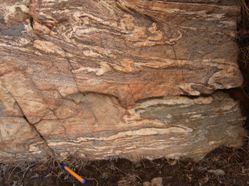
CONTINENTAL COLLISION
Not surprisingly for such a striking example of a young continental collision zone, the Himalaya has proved a hotbed of theories for mountain-building processes for over a century (see box text). A popular recent model attributes the highly-deformed, high grade gneisses of the Himalayan core to ‘channel flow’, where rocks at a certain depth in the middle crust partially melt, triggering ductile flow of these rocks back towards the mountain front, where they are then exhumed by rapid erosion. This process has been likened to squeezing toothpaste out of a tube.
However, evidence is emerging in Bhutan that motion on major shear zones, which dragged the high-grade rocks up from the middle crust, was not restricted to a single, simple episode of channel flow, but switched both southwards and northwards, exhuming different bodies of rock at different times. This may reflect doming and re-organization of the mid-crustal channel
3, or the dynamic response of a large-scale orogenic wedge, for instance by out-of-sequence thrusting in northern Bhutan.
By trekking to the area around Laya village, we hoped to locate and map one of these major fault contacts, confirm how gneisses above and below the fault had been displaced by the fault, and collect samples for further analysis – to find out how hot and deep the rocks were when they were deformed.
Analysis of thin sections of the rocks should tell us the P-T conditions in the footwall and hanging wall of the shear zone, as well as the conditions during actual shearing. Combining these data with existing dates on the gneisses juxtaposed across the shear zone will provide us with a crucial piece of the Himalayan puzzle in Bhutan.